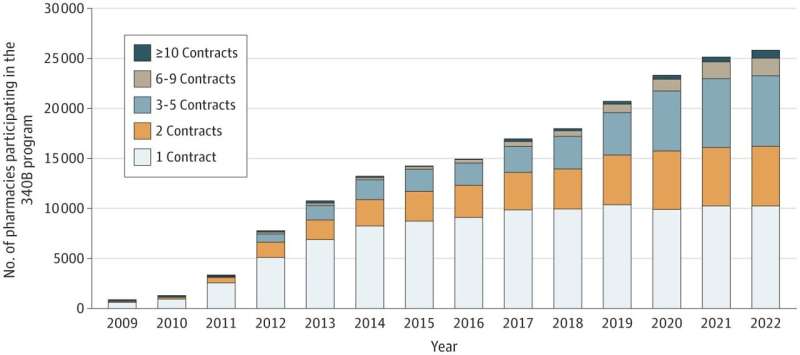This article has been reviewed according to Science X's editorial process and policies. Editors have highlighted the following attributes while ensuring the content's credibility:
fact-checked
peer-reviewed publication
trusted source
proofread
Study tracks the number of pharmacies participating in discounted drug pricing program

For more than 30 years, section 340B of the Public Health Service Act has required drug manufacturers to sell outpatient drugs at discounted prices to certain safety-net hospitals and health care organizations that serve uninsured or low-income patients. 340B-eligible health care providers (called "covered entities") contract with pharmacies to dispense the discounted drugs—a mutually beneficial relationship that increases revenue for providers and pharmacies. Today, about 40% of retail pharmacies across the country have at least one contract with a 340B-eligible health care provider.
A new study from the University of Minnesota School of Public Health (SPH) examines recent trends in the relationship between pharmacies and 340B-eligible covered entities (CEs). The study takes an in-depth look at pharmacies' relationship with health care providers by developing new measures to describe alternative forms of contract pharmacy growth beyond simple participation rates.
Specifically, the study looked at how pharmacies' involvement with 340B has changed between 2009 and 2022 in three key metrics developed by the researchers:
- Depth, which measures the number of contracts each pharmacy in the U.S. holds.
- Spread, which measures how far pharmacies are geographically from the covered entity.
- Safety-net composition, which is the proportion of a pharmacy's contracts that are with covered entities that are "essential community providers," as measured by the Medicaid and Children's Health Insurance Program Payment and Access Commission.
The study, published in JAMA Health Forum, found:
- The overall number of pharmacies participating in 340B increased dramatically, from 789 in 2009 to 25,775 in 2022. In 2009, 1.3% of retail pharmacies participated in 340B, compared to 40.9% in 2022.
- Depth increased. In 2009, 81% of retail pharmacies had only one contract, and by 2022, 40% had one, 23% had two, 27% had three to five, 7% had six to nine, and 3% had 10 or more.
- Spread also increased. In 2009, the farthest CE was within the same zip code for 48% of pharmacies. By 2022, only 9% of CEs were in the same zip code.
- Safety-net composition decreased. In 2009, 95% of pharmacies contracted exclusively with safety-net hospitals and clinics. By 2022, only 54% of pharmacies contracted exclusively with safety-net facilities, and 16% contracted with no safety-net facilities.
"The 340B Drug Pricing Program aims to improve access to care for patients who rely on the health care safety net," said Sayeh Nikpay, SPH associate professor and lead author of the study. "Historically this program has involved the hospitals and their clinics that participate in the program. However, our study documents that pharmacies are playing a growing role in the program. Whether this growing participation furthers the program's goals of increasing access to the care for patients who rely on the safety-net has yet to be seen."
Limitations of the study include the lack of data on the volume of 340B drugs dispensed through retail pharmacies, which would have allowed the researchers to differentiate contracts by profitability. Also, the study's focus on retail pharmacies meant that data on mail-order and specialty pharmacies was not included. Nikpay is currently working on research that would address specialty and mail-order pharmacies.
More information: Sayeh Nikpay et al, Trends in 340B Drug Pricing Program Contract Growth Among Retail Pharmacies From 2009 to 2022, JAMA Health Forum (2023). DOI: 10.1001/jamahealthforum.2023.2139




















